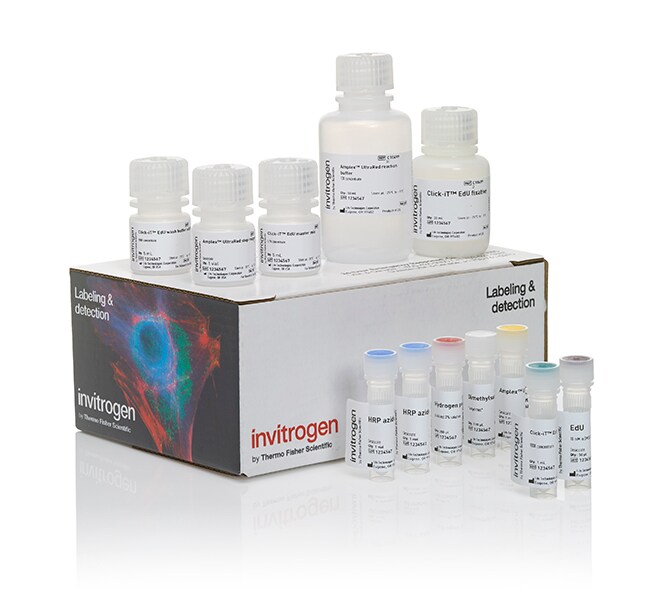Search Thermo Fisher Scientific

Click-iT™ EdU Proliferation Assay for Microplates
| Catalog Number | Quantity |
|---|---|
| C10499 | 400 Assays |
Click-iT EdU Proliferation Assay for Microplates features include:
• Improved performance—direct conjugation of HRP to incorporated EdU improves assay sensitivity and accuracy
• Increased reliability—assay format results in low well-to-well variability
• Simplified protocol—results in reduced time to data; easier to follow protocol
• Multiplex enabled—assay can be easily multiplexed with other cell health reagents resulting in more data per sample
Measuring cell proliferation is a fundamental method of assessing cell health, determining genotoxicity, and evaluating anti-cancer drugs. The most accurate method of measuring proliferation is by direct detection of DNA synthesis. Originally this was accomplished through incorporation of a radioactive nucleoside (e.g., 3H-thymidine). This method was replaced by antibody-based detection of the nucleoside analog bromo-deoxyuridine (BrdU). After incorporation of BrdU into the newly synthesized DNA, denaturation is required to expose the BrdU molecules to the anti-BrdU antibody. The denaturation involves harsh methods (HCl, heat, or enzymes) and is time consuming and difficult to perform consistently.
The Click-iT EdU Proliferation Assay is an alternative to the BrdU assay. The nucleoside analog EdU (5-ethynyl-2´-deoxyuridine) is added to live cells and incorporated into DNA during active DNA synthesis. The incorporated EdU contains an alkyne group which is covalently joined to the azide group present in HRP using a highly specific copper-catalyzed covalent reaction ('click reaction'). Amplex UltraRed Reagent is then added and its conversion by HRP into a highly fluorescent product is recorded using a fluorescence microplate reader (excitation: 568, emission: 585 nm). With a high extinction coefficient, good quantum efficiency, and resistance to auto-oxidation, Amplex UltraRed Reagent delivers higher sensitivity and a broader assay range than other fluorogenic or colorimetric HRP substrates. It also offers versatility through detection by either fluorescence or absorbance measurement.
Compared to anti-BrdU-based microplate proliferation assays, the Click-iT EdU Proliferation Assay uses small reaction moieties and does not require antibodies or DNA denaturation, both of which can reduce assay performance. Additionally, streptavidin-biotin binding is not required, eliminating the necessary biotin blocking steps required by cells possessing high levels of endogenous biotin.
Figures




Customers who viewed this item also viewed
Documents & Downloads
Certificates
Safety Data Sheets
Frequently asked questions (FAQs)
If the Amplex UltraRed reagent was spontaneously oxidized, all samples would have high levels of signal. The lack of any signal indicates that some component in the reaction is non-functional or little or no EdU was incorporated by the cells. The HRP-azide (Component B), the Click-iT EdU reaction additive (Component F), and the hydrogen peroxide (Component J) are the most labile components in the kit. HRP can be denatured and inhibited by sodium azide. The Click-iT Edu reaction additive (Component F) should be diluted only shortly before use and dilute solutions should not be stored. Hydrogen peroxide does spontaneously degrade over time, but more readily when diluted; prepare the hydrogen peroxide stock solution shortly before use and do not store.
Find additional tips, troubleshooting help, and resources within our Cell Analysis Support Center.
This may be possible, but the final working concentrations and incubation steps would have to be optimized by the user. Be advised that chromogenic substrates are not as sensitive as the fluorogenic Amplex UltraRed reagent.
Find additional tips, troubleshooting help, and resources within our Cell Analysis Support Center.
The Click-iT EdU Cell Proliferation Assay for Microplates protocol requires samples to be fixed and permeabilized prior to the click reaction. Most endogenous peroxidases may be inactivated after fixation/permeabilization and after the click reaction. If this is of concern, apply the Amplex UltraRed reaction mixture without added H2O2 to the samples after fixation, but before the click reaction (i.e., no HRP-azide added to the sample). In the absence of added H2O2 and HRP-azide, if you see any change in Amplex UltraRed fluorescence intensity, this is indicative of endogenous peroxidase activity.
Find additional tips, troubleshooting help, and resources within our Cell Analysis Support Center.